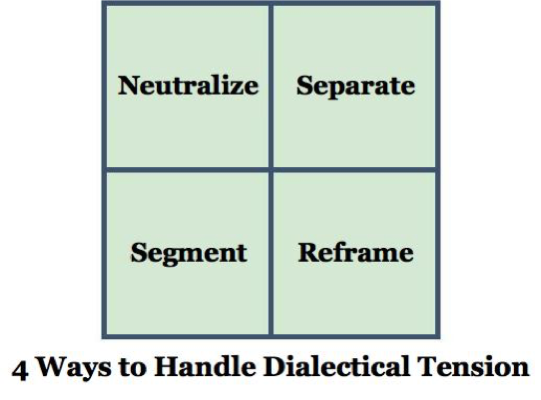In this section, we will cover techniques for managing relational dialectics, address contextual nuances surrounding self-disclosure, and discuss the importance of reflecting on how technology impacts others and our relationships
8.3.1: Effective Communication: Managing Relational Dialectics
 (Image: Spaynton, CC BY-SA 4.0)
(Image: Spaynton, CC BY-SA 4.0)
In section 8.2.3.1, we discussed the three dialectics that influence relationship dynamics: autonomy-connection, novelty-predictability, and openness-closedness. Understanding that these three dialectical tensions are at play in all relationships is a first step in understanding how our relationships work. Since the way we communicate our needs (or don’t communicate them) and respond to the needs of others can have both a short and long-term impact on our relationships, we need to learn how to manage dialectics to enhance relationship satisfaction. Depending on the relational context (the nature of the relationship between two people), couples, friends, or family members may have different strategies for managing these tensions in an attempt to meet the needs of each person. Baxter (1988) identifies four ways we can handle dialectical tensions.
- Neutralize:
The first option is to neutralize the extremes of the dialectical tensions. Here, individuals compromise, creating a solution where neither person’s need (such as novelty or predictability) is fully satisfied. Individual needs may be different and never fully realized. For example, if one person seeks a great deal of autonomy, and the other person in the relationship seeks a great deal of connection, neutralization would not make it possible for either person to have their desires met. Instead, each person might feel like they are not getting quite enough of their particular need met.
- Separation:
The second option is separation. This is when someone favors one end of the dialectical continuum and ignores the other, or alternates between the extremes. For example, a couple in a long-distance relationship in which each person works in a different city may decide to live apart during the week (autonomy) and be together on the weekends (connection). In this sense, they are alternating between the extremes by being completely alone during the week, yet completely together on the weekends.
- Segmentation:
When people decide to divide their lives into spheres they are practicing segmentation. For example, your extended family may be very close and choose to spend religious holidays together. However, members of your extended family might reserve other special days such as birthdays for celebrating with friends. This approach divides needs according to the different segments of your life.
- Reframing:
The final option for dealing with these tensions is a creative technique called reframing. This strategy requires creativity not only in managing the tensions, but also in understanding how they work in the relationship. For example, the two ends of the dialectic are not viewed as opposing or contradictory at all. Instead, they are understood as supporting the other need, as well as the relationship itself. A couple who does not live together, for example, may agree to spend two nights of the week alone or with friends as a sign of their autonomy. The time spent alone or with others may be viewed less as a compromise and more as an opportunity to develop themselves and their own interests so that they are better able to share themselves with their partner and enhance their connection.
Relational dialectics are a natural part of our relationships, and there is no one right way to understand and manage dialectical tensions since every relationship is unique. However, to always satisfy one need and ignore the other may be a sign of trouble in the relationship (Baxter, 1988). Therefore it is important to reflect on both our dialectics needs and that of the other and to remember that we have a lot of choice, freedom, and creativity in how we work them out with our relational partners. It is also important to remember that dialectical tensions are negotiated differently in each relationship. The ways we manage dialectical tensions contributes greatly to the communication climate in relationships.
8.3.2: Contextual Communication: Self-Disclosure and Context

It’s important to pay attention to contextual nuances when disclosing information to others. For example, the physical context- where an interaction takes place- can either facilitate or hinder disclosure.
While the mutual disclosure of information can bring people together and strengthen a relationship, inappropriately disclosing information—either to the wrong person, at the wrong place, or at the wrong time—can have negative effects. Below we discuss some contextual nuances to keep in mind when disclosing (or not disclosing) to others.
- Physical Context:
The physical context in which an interaction takes places can influence the types of disclosure. A quiet coffee shop or the privacy of a home may facilitate disclosure while crowded, public places may not. Disclosing sensitive information in the wrong place can have negative results. For example, disclosing to your long-time romantic partner in a public place (such as a dinner party) that you cheated on them may not go over so well. However, other times you may elect to disclosure in a public place, such as when you fear a violent reaction. Physical context can also encompass virtual spaces, such as social networking sites. Some sites, such as Facebook or Twitter encourage the disclosing of private and personal information. However, if using a social networking site like LinkedIn, you should keep your disclosures professional. When disclosing in online platforms, also keep in mind that what you disclose can never be reversed and may be shared with others.
- Relational Context:
The relational context, or the relationship between two people, is important to consider when deciding what we should or should not disclose. Generally speaking, personal and private matters are appropriate to discuss in ongoing intimate personal relationships, such as friendships and romantic relationships. However, if you are in a professional relationship, such as those that take place in the workplace, you should typically avoid disclosing overly personal information (unless you are also in an intimate relationship with that individual). When in professional contexts, avoid discussing overly personal information and/or asking others to disclose overly personal information about themselves. When choosing to disclose information to another, consider both the potential positive and negative effects of said disclosure. If you are in an intimate personal relationship, disclosure can enhance the relationship and bring people closer. However, when you disclose information to another, it can potentially have negative repercussions if that person shares your private information, thoughts, or feelings with others. For example, if you disclose to a coworker that you dislike another coworker, they may tell that person, which could in turn cause unwanted workplace conflict.
- Individual Context:
Individual context and internal motivations will also influence self-disclosure. Some people may disclose more information than others or do so more quickly while others may take more time or be more hesitant. Some people may be motivated to get something off their chest or be seeking advice, support, or validation. However, others may feel vulnerable in disclosing information or fear of a negative reaction and/or rejection. Our past experiences may also influence how much we disclose and who we disclose to. For example, if you have had negative experiences in the past with friends sharing your private information with others, you may be more hesitant to disclose in the future.
- Cultural/Co-Cultural Context:
Cultural rules and norms exist for disclosure in terms of the privacy and openness surrounding particular topics and what is considered acceptable to disclose (or not), depending on other contextual nuances such as physical location and/or the type of relationship. For example, some cultures value directness and openness while others value privacy. Co-cultural factors also influence disclosures. In particular, gender differences for males and females exist in terms of topics considered okay to talk about and amount of disclosure. Females are typically socialized to disclose more than males, especially when it comes to topics such as feelings and emotions.
8.3.3: Reflective Communication: Technology and Relationships
Technology has vastly reshaped how we form relationships and communicate with others, whether it be strangers, friends, family, or romantic partners. Reflecting on how we use technology is important, as it may affect others and contribute to relationship satisfaction (or dissatisfaction).
- Others:
Technology enables anonymity and provides a screen for us to ‘hide’ behind, which can be both good and bad. One advantage is that we may be able to say and communicate things to others that we might not otherwise be able to in face-to-face interactions because of anxiety, fear, and/or vulnerability. However, the disadvantage is that when we can’t see the other person immediately in front of us, we may have less empathy and may say things that we would never say face-to-face. Anonymity can make people less accountable and responsible for their actions. Bullying and flaming (verbally attacking others) are common online and can have adverse effects on others. Taken to the extreme, cyber-bullying has even impacted others to the point where they have attempted suicide or taken their own lives. So, while technology may empower us in some ways, we should keep in mind the famous quote “With great power comes great responsibility.”
- Relationships:
Finally, technology can both positively and negatively affect the satisfaction of relationships during the beginning, developing, and maintaining stages. As an advantage, we can use technology to begin, develop, and maintain relationships with those who are not in our geographic location. This is beneficial for families, friendships, and romantic relationships where people are separated by distance. For example, if you are in a romantic relationship with a member of the military who gets stationed for three months overseas, you can stay in contact and still maintain a level of closeness that may have been more difficult to achieve in the past. Even little text messages asking about someone’s day or saying “I love you” can help increase overall relationship satisfaction by letting others know we are thinking of them. However, if used too much in relationships, technology may have a negative impact. It’s common to go out to restaurant or bar and observe couples or groups staring at their phone screens versus interacting with each other. Over time, these types of behaviors may lead to people not feeling as close in a relationship and/or relationship deterioration. In addition, the things we post online may impact a relationship. For example, let’s say you told a friend you were staying in for the night but then ended up going to a party. While at the party another friend takes and posts a photo of you on Facebook. When your other friend sees this, it may result in hurt feelings and/or a fight.